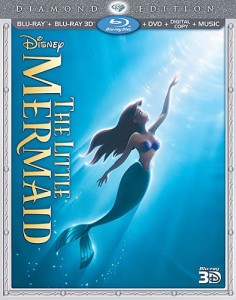Peter Pan
Posted on December 13, 2002 at 5:17 am
B+| Lowest Recommended Age: | Kindergarten - 3rd Grade |
| Profanity: | None |
| Alcohol/ Drugs: | None |
| Violence/ Scariness: | Characters in peril; a swordfight |
| Diversity Issues: | Sexist comments about girls, insensitive comments about Indians |
| Date Released to Theaters: | 1953 |
| Date Released to DVD: | February 4, 2013 |
| Amazon.com ASIN: | B00A0MJ9ZA |
Disney’s latest release is a beautiful Blu-Ray of one of its animated classics, the Disney version of the Victorian classic about the boy who would never grow up. Wendy, Michael, and John Darling, three London children, meet Peter Pan, a boy who can fly. He has been drawn to their warm, comfortable home, and to Wendy’s stories. He sprinkles them with fairy dust and they fly off past the “second star to the right,” where he lives in a magical place called Neverland. There they rescue an Indian princess, and fight pirates led by Captain Hook, before returning home to wave goodbye as Peter returns to Neverland without them.
 The animation in this movie is as lively as its energetic hero. The scenes set in Victorian London are beautiful, and the shift in perspective as the children round Big Ben and fly off to Neverland is sublimely vertiginous.
The animation in this movie is as lively as its energetic hero. The scenes set in Victorian London are beautiful, and the shift in perspective as the children round Big Ben and fly off to Neverland is sublimely vertiginous.
Most children see Peter as that wonderful ideal, a child with the power to do whatever he pleases for as long as he pleases. The story does have moments that are whimsical but also very odd — the nanny is a dog, the crocodile that ate Captain Hook’s hand keeps following him for another taste, Peter loses his shadow, the Lost Boys have no parents, and unlike Peter, no special powers, fairy guardian, or unquenchable brio. Some children find this engaging, but a few find it troublesome, or worry about what happened to Peter’s parents and whether he will be all right without them. They may also be sad that the story ends with Peter bringing the Darling children home and then going back to Neverland without them.
Parents should know that the “What Makes the Red Man Red” song is embarrassingly racist and sexist. There is also a sexist overlay to the entire story, with Peter rapturously adored by all the females and at best indifferent in return. A best-selling pop psychology book of some years ago played off of this notion, theorizing that some men suffer from “The Peter Pan Syndrome” (fear of commitment), dividing women into two categories, mother-figure “Wendys” and playmate “Tinkerbells.” Tinkerbell, who is, of course, a fairy, is the only female in the story who is capable of much action other than nurturing, and she is petty and spiteful (though ultimately loyal). When he first meets Wendy, Peter says “Girls talk too much,” which one boy who watched with me thought was rapturously funny.
Families who watch this movie should talk about these questions: Have you ever thought that you didn’t want to grow up? Have you ever thought that you’d like to be a grown up right now? What would you do? Would you like to visit Neverland?
Families who enjoy this movie will also enjoy the many other versions of this popular story. Interestingly, this animated version was the first to feature a real boy (instead of a woman) in the title role. The Mary Martin version for television that parents of today’s kids may remember from their own childhoods is available on video, with Cyril Ritchard impeccable as Mr. Darling/Captain Hook, and a terrific score that includes “I’m Flying” and “Tender Shepherd.” A remake with Cathy Rigby as a very athletic Peter is also very good. Don’t waste your time on Steven Spielberg’s 1991 sequel, “Hook,” with Robin Williams as a grown- up Peter Pan who must go back to rescue his children from Dustin Hoffman as Captain Hook with the help of Julia Roberts as Tinkerbell. The stars, the production design, and some spectacular special effects cannot make up for the incoherent joylessness of the script and genuinely disturbing moments like the death of one of the lost boys.

